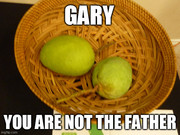So does the shape of the pollinated fruit offer hints as to the pollen used to fertilize the embryo to create that fruit? I think the answer to that question is that it depends on the species.
Weirdly it's not a factor for most fruit except Annona like Cherimoya, where the pollen used in fertilization can affect the shape of the fruit as it develops.
That said, it's not a helpful tool most of the time, and you can use techniques to verify the pollen parent by bagging flowers and removing the pollen of the flower after pollinating, but before the flower enters male stage and the pollen dehisces.
Are you trying to use crossing as a tool to learn more about the variety you obtain pollen of?
Otherwise I don't see the use of this tool, and even if that is the goal it seems that it really only plays a factor in fruit shape if I understood what I've read correctly.
Factors like fruit shape don't necessarily play into the progeny though, it depends on phenotypic inheritance.
Some trait genes are dominant, and will more than likely affect the resultant cross. Others can be reflected partway or blended. Some are recessive and are less likely to be reflected in the cross, and may take multiple generations of selection to be reflected in a cross.
Let's take mango seed polyembryony as an example.
The seed polyembryony is affected by a single gene, and the trait is inherited in a dominant pattern similarly to gender in humans. They aren't referred to as "X" and "Y" due to them not having this characteristic shape, but they do follow a similar pattern, so we can call them "X" and "Y" for demonstrative purposes. Similar to how "X" works for humans, the gene that carries the trait for mango seed monoembryony is inherited recessively. Therefore you can get monoembryonic offspring from polyembryonic parents, and at a ratio of 25% if both parents are polyembryonic, and 50% if one parent is monoembryonic. If both parents are monoembryonic the result of their crossing will yield 100% monoembryonic offspring. This discussion only applies to zygotic seedlings.
For typing mango offspring, this is most helpful for determining the the potential parent of a cross. If you have three mango trees in your yard, in this example a monoembryonic type, a polyembryonic type, and a seedling of the monoembryonic type, and it's assumed that no outcrossing is possible, you may potentially be able to identify the parent of the offspring if it produces fruit with polyembryonic seeds. That said, we don't seem to have any mango "breeders" as such, only mango "selectors," and "selectors" don't select on genotypic traits, but phenotypic, or "expressed" traits. You get a lot of confusion when purported parentage of mango selections are espoused, often leading to forum discussions similar to that you might overhear on daytime television.


